MS40046E - Donoghue v Stevenson Case Study: Business Law Principles
VerifiedAdded on 2023/04/22
|8
|1890
|201
Case Study
AI Summary
This document provides a detailed case study analysis of Donoghue v Stevenson, a landmark case in business law concerning negligence and duty of care. The analysis includes the facts of the case, the different stages of court proceedings, the judges involved, and a summary of the final decision of the House of Lords. It delves into the reasoning behind the final decisions, exploring the neighbor principle introduced by Lord Atkin and referencing other relevant cases such as Heaven v Pender and MacPherson v. Buick Motor Co. The document also presents opposing opinions from judges like Lord Buckmaster and Lord Tomlin, who favored adhering to established precedents. Ultimately, the analysis highlights the significance of Donoghue v Stevenson in establishing the modern concept of negligence and its impact on product liability.
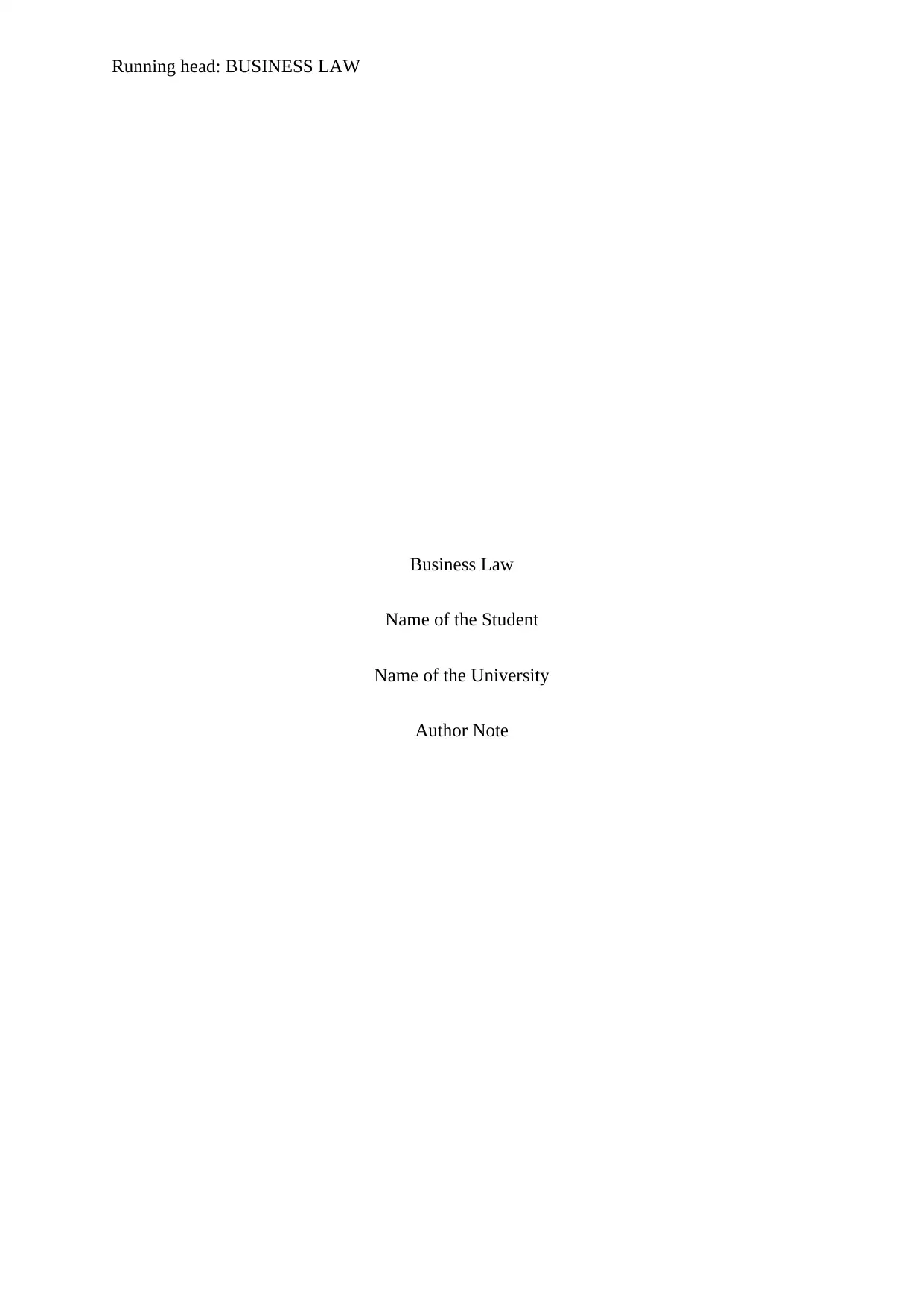
Running head: BUSINESS LAW
Business Law
Name of the Student
Name of the University
Author Note
Business Law
Name of the Student
Name of the University
Author Note
Paraphrase This Document
Need a fresh take? Get an instant paraphrase of this document with our AI Paraphraser
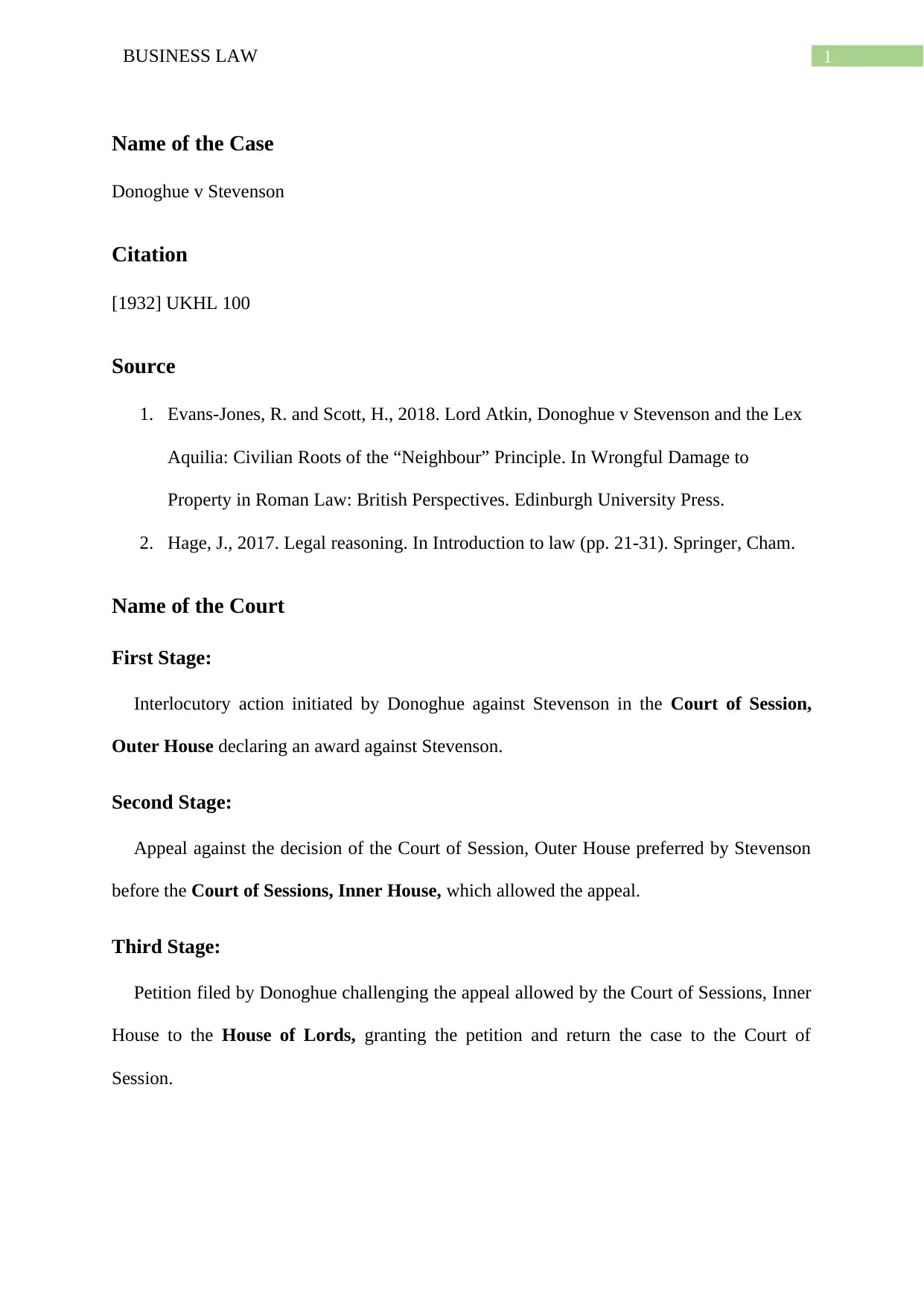
1BUSINESS LAW
Name of the Case
Donoghue v Stevenson
Citation
[1932] UKHL 100
Source
1. Evans-Jones, R. and Scott, H., 2018. Lord Atkin, Donoghue v Stevenson and the Lex
Aquilia: Civilian Roots of the “Neighbour” Principle. In Wrongful Damage to
Property in Roman Law: British Perspectives. Edinburgh University Press.
2. Hage, J., 2017. Legal reasoning. In Introduction to law (pp. 21-31). Springer, Cham.
Name of the Court
First Stage:
Interlocutory action initiated by Donoghue against Stevenson in the Court of Session,
Outer House declaring an award against Stevenson.
Second Stage:
Appeal against the decision of the Court of Session, Outer House preferred by Stevenson
before the Court of Sessions, Inner House, which allowed the appeal.
Third Stage:
Petition filed by Donoghue challenging the appeal allowed by the Court of Sessions, Inner
House to the House of Lords, granting the petition and return the case to the Court of
Session.
Name of the Case
Donoghue v Stevenson
Citation
[1932] UKHL 100
Source
1. Evans-Jones, R. and Scott, H., 2018. Lord Atkin, Donoghue v Stevenson and the Lex
Aquilia: Civilian Roots of the “Neighbour” Principle. In Wrongful Damage to
Property in Roman Law: British Perspectives. Edinburgh University Press.
2. Hage, J., 2017. Legal reasoning. In Introduction to law (pp. 21-31). Springer, Cham.
Name of the Court
First Stage:
Interlocutory action initiated by Donoghue against Stevenson in the Court of Session,
Outer House declaring an award against Stevenson.
Second Stage:
Appeal against the decision of the Court of Session, Outer House preferred by Stevenson
before the Court of Sessions, Inner House, which allowed the appeal.
Third Stage:
Petition filed by Donoghue challenging the appeal allowed by the Court of Sessions, Inner
House to the House of Lords, granting the petition and return the case to the Court of
Session.
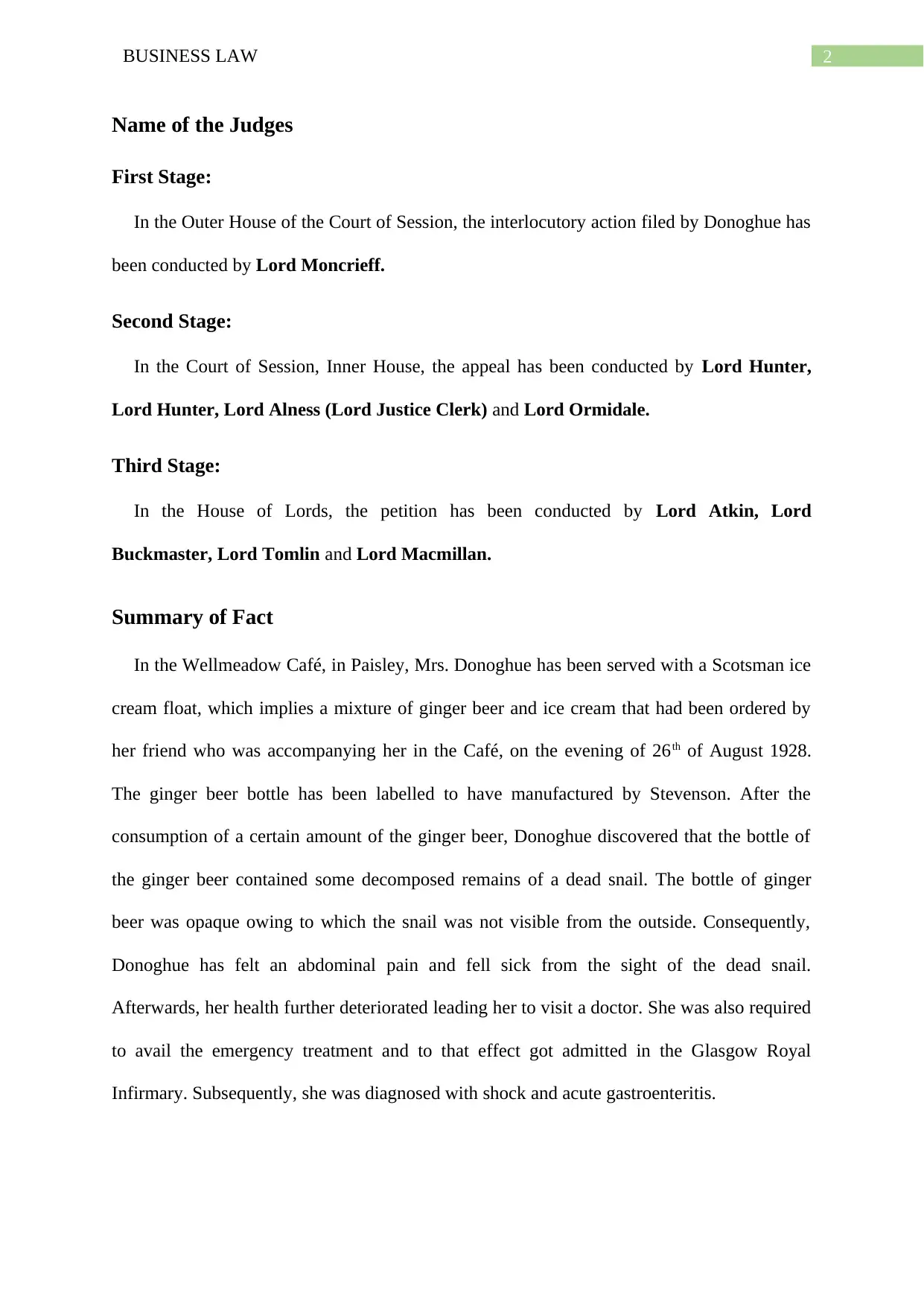
2BUSINESS LAW
Name of the Judges
First Stage:
In the Outer House of the Court of Session, the interlocutory action filed by Donoghue has
been conducted by Lord Moncrieff.
Second Stage:
In the Court of Session, Inner House, the appeal has been conducted by Lord Hunter,
Lord Hunter, Lord Alness (Lord Justice Clerk) and Lord Ormidale.
Third Stage:
In the House of Lords, the petition has been conducted by Lord Atkin, Lord
Buckmaster, Lord Tomlin and Lord Macmillan.
Summary of Fact
In the Wellmeadow Café, in Paisley, Mrs. Donoghue has been served with a Scotsman ice
cream float, which implies a mixture of ginger beer and ice cream that had been ordered by
her friend who was accompanying her in the Café, on the evening of 26th of August 1928.
The ginger beer bottle has been labelled to have manufactured by Stevenson. After the
consumption of a certain amount of the ginger beer, Donoghue discovered that the bottle of
the ginger beer contained some decomposed remains of a dead snail. The bottle of ginger
beer was opaque owing to which the snail was not visible from the outside. Consequently,
Donoghue has felt an abdominal pain and fell sick from the sight of the dead snail.
Afterwards, her health further deteriorated leading her to visit a doctor. She was also required
to avail the emergency treatment and to that effect got admitted in the Glasgow Royal
Infirmary. Subsequently, she was diagnosed with shock and acute gastroenteritis.
Name of the Judges
First Stage:
In the Outer House of the Court of Session, the interlocutory action filed by Donoghue has
been conducted by Lord Moncrieff.
Second Stage:
In the Court of Session, Inner House, the appeal has been conducted by Lord Hunter,
Lord Hunter, Lord Alness (Lord Justice Clerk) and Lord Ormidale.
Third Stage:
In the House of Lords, the petition has been conducted by Lord Atkin, Lord
Buckmaster, Lord Tomlin and Lord Macmillan.
Summary of Fact
In the Wellmeadow Café, in Paisley, Mrs. Donoghue has been served with a Scotsman ice
cream float, which implies a mixture of ginger beer and ice cream that had been ordered by
her friend who was accompanying her in the Café, on the evening of 26th of August 1928.
The ginger beer bottle has been labelled to have manufactured by Stevenson. After the
consumption of a certain amount of the ginger beer, Donoghue discovered that the bottle of
the ginger beer contained some decomposed remains of a dead snail. The bottle of ginger
beer was opaque owing to which the snail was not visible from the outside. Consequently,
Donoghue has felt an abdominal pain and fell sick from the sight of the dead snail.
Afterwards, her health further deteriorated leading her to visit a doctor. She was also required
to avail the emergency treatment and to that effect got admitted in the Glasgow Royal
Infirmary. Subsequently, she was diagnosed with shock and acute gastroenteritis.
⊘ This is a preview!⊘
Do you want full access?
Subscribe today to unlock all pages.

Trusted by 1+ million students worldwide
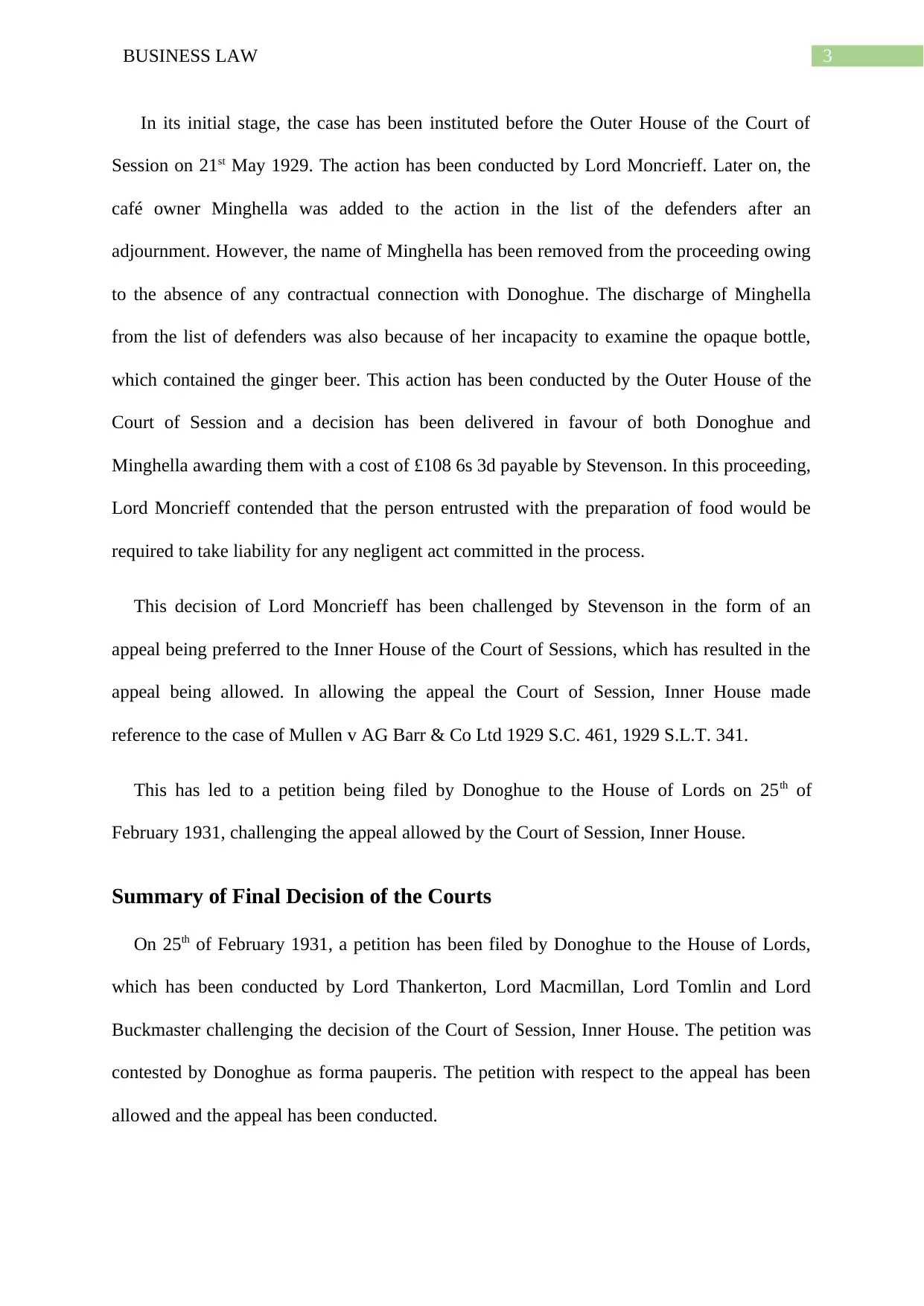
3BUSINESS LAW
In its initial stage, the case has been instituted before the Outer House of the Court of
Session on 21st May 1929. The action has been conducted by Lord Moncrieff. Later on, the
café owner Minghella was added to the action in the list of the defenders after an
adjournment. However, the name of Minghella has been removed from the proceeding owing
to the absence of any contractual connection with Donoghue. The discharge of Minghella
from the list of defenders was also because of her incapacity to examine the opaque bottle,
which contained the ginger beer. This action has been conducted by the Outer House of the
Court of Session and a decision has been delivered in favour of both Donoghue and
Minghella awarding them with a cost of £108 6s 3d payable by Stevenson. In this proceeding,
Lord Moncrieff contended that the person entrusted with the preparation of food would be
required to take liability for any negligent act committed in the process.
This decision of Lord Moncrieff has been challenged by Stevenson in the form of an
appeal being preferred to the Inner House of the Court of Sessions, which has resulted in the
appeal being allowed. In allowing the appeal the Court of Session, Inner House made
reference to the case of Mullen v AG Barr & Co Ltd 1929 S.C. 461, 1929 S.L.T. 341.
This has led to a petition being filed by Donoghue to the House of Lords on 25th of
February 1931, challenging the appeal allowed by the Court of Session, Inner House.
Summary of Final Decision of the Courts
On 25th of February 1931, a petition has been filed by Donoghue to the House of Lords,
which has been conducted by Lord Thankerton, Lord Macmillan, Lord Tomlin and Lord
Buckmaster challenging the decision of the Court of Session, Inner House. The petition was
contested by Donoghue as forma pauperis. The petition with respect to the appeal has been
allowed and the appeal has been conducted.
In its initial stage, the case has been instituted before the Outer House of the Court of
Session on 21st May 1929. The action has been conducted by Lord Moncrieff. Later on, the
café owner Minghella was added to the action in the list of the defenders after an
adjournment. However, the name of Minghella has been removed from the proceeding owing
to the absence of any contractual connection with Donoghue. The discharge of Minghella
from the list of defenders was also because of her incapacity to examine the opaque bottle,
which contained the ginger beer. This action has been conducted by the Outer House of the
Court of Session and a decision has been delivered in favour of both Donoghue and
Minghella awarding them with a cost of £108 6s 3d payable by Stevenson. In this proceeding,
Lord Moncrieff contended that the person entrusted with the preparation of food would be
required to take liability for any negligent act committed in the process.
This decision of Lord Moncrieff has been challenged by Stevenson in the form of an
appeal being preferred to the Inner House of the Court of Sessions, which has resulted in the
appeal being allowed. In allowing the appeal the Court of Session, Inner House made
reference to the case of Mullen v AG Barr & Co Ltd 1929 S.C. 461, 1929 S.L.T. 341.
This has led to a petition being filed by Donoghue to the House of Lords on 25th of
February 1931, challenging the appeal allowed by the Court of Session, Inner House.
Summary of Final Decision of the Courts
On 25th of February 1931, a petition has been filed by Donoghue to the House of Lords,
which has been conducted by Lord Thankerton, Lord Macmillan, Lord Tomlin and Lord
Buckmaster challenging the decision of the Court of Session, Inner House. The petition was
contested by Donoghue as forma pauperis. The petition with respect to the appeal has been
allowed and the appeal has been conducted.
Paraphrase This Document
Need a fresh take? Get an instant paraphrase of this document with our AI Paraphraser
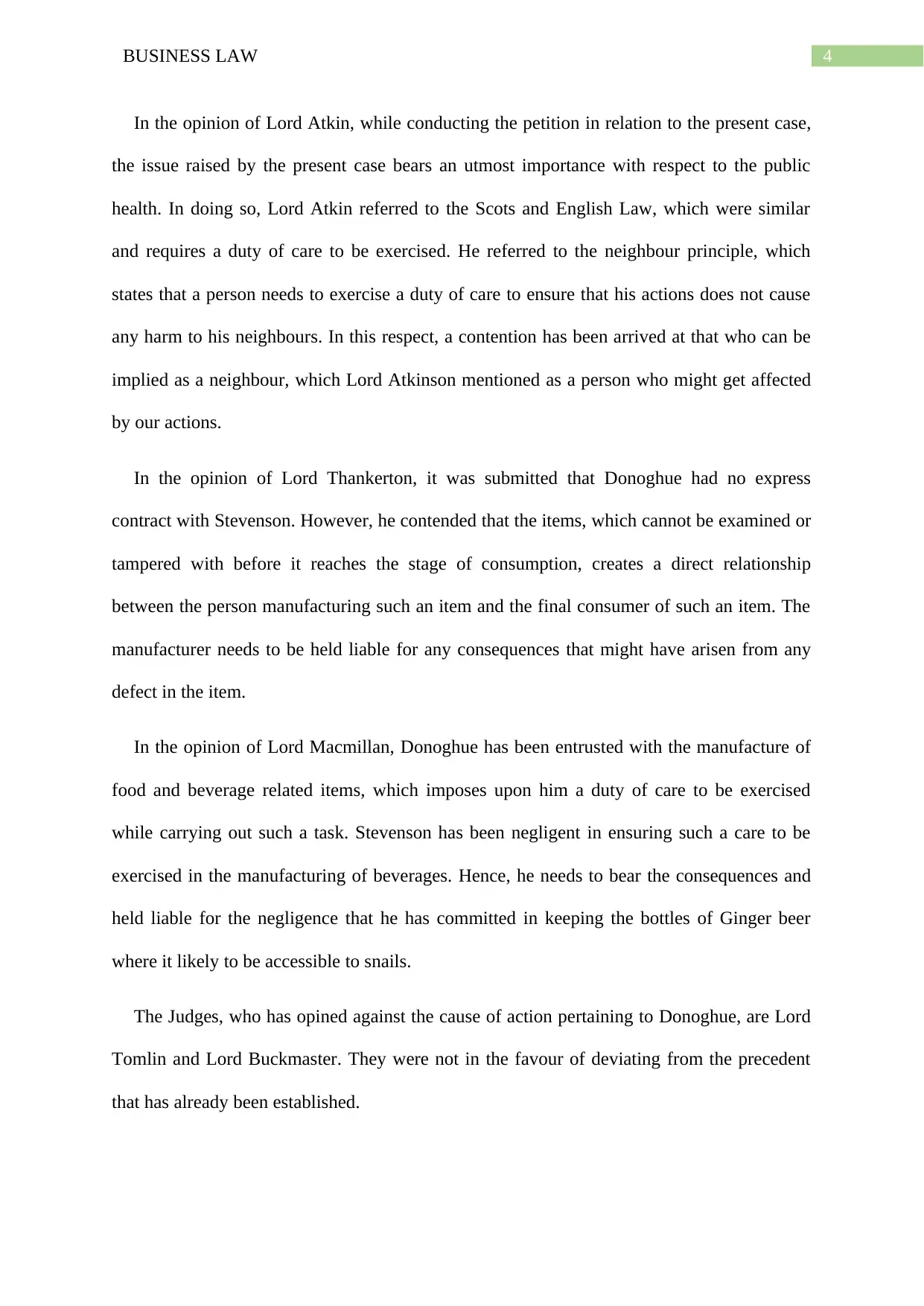
4BUSINESS LAW
In the opinion of Lord Atkin, while conducting the petition in relation to the present case,
the issue raised by the present case bears an utmost importance with respect to the public
health. In doing so, Lord Atkin referred to the Scots and English Law, which were similar
and requires a duty of care to be exercised. He referred to the neighbour principle, which
states that a person needs to exercise a duty of care to ensure that his actions does not cause
any harm to his neighbours. In this respect, a contention has been arrived at that who can be
implied as a neighbour, which Lord Atkinson mentioned as a person who might get affected
by our actions.
In the opinion of Lord Thankerton, it was submitted that Donoghue had no express
contract with Stevenson. However, he contended that the items, which cannot be examined or
tampered with before it reaches the stage of consumption, creates a direct relationship
between the person manufacturing such an item and the final consumer of such an item. The
manufacturer needs to be held liable for any consequences that might have arisen from any
defect in the item.
In the opinion of Lord Macmillan, Donoghue has been entrusted with the manufacture of
food and beverage related items, which imposes upon him a duty of care to be exercised
while carrying out such a task. Stevenson has been negligent in ensuring such a care to be
exercised in the manufacturing of beverages. Hence, he needs to bear the consequences and
held liable for the negligence that he has committed in keeping the bottles of Ginger beer
where it likely to be accessible to snails.
The Judges, who has opined against the cause of action pertaining to Donoghue, are Lord
Tomlin and Lord Buckmaster. They were not in the favour of deviating from the precedent
that has already been established.
In the opinion of Lord Atkin, while conducting the petition in relation to the present case,
the issue raised by the present case bears an utmost importance with respect to the public
health. In doing so, Lord Atkin referred to the Scots and English Law, which were similar
and requires a duty of care to be exercised. He referred to the neighbour principle, which
states that a person needs to exercise a duty of care to ensure that his actions does not cause
any harm to his neighbours. In this respect, a contention has been arrived at that who can be
implied as a neighbour, which Lord Atkinson mentioned as a person who might get affected
by our actions.
In the opinion of Lord Thankerton, it was submitted that Donoghue had no express
contract with Stevenson. However, he contended that the items, which cannot be examined or
tampered with before it reaches the stage of consumption, creates a direct relationship
between the person manufacturing such an item and the final consumer of such an item. The
manufacturer needs to be held liable for any consequences that might have arisen from any
defect in the item.
In the opinion of Lord Macmillan, Donoghue has been entrusted with the manufacture of
food and beverage related items, which imposes upon him a duty of care to be exercised
while carrying out such a task. Stevenson has been negligent in ensuring such a care to be
exercised in the manufacturing of beverages. Hence, he needs to bear the consequences and
held liable for the negligence that he has committed in keeping the bottles of Ginger beer
where it likely to be accessible to snails.
The Judges, who has opined against the cause of action pertaining to Donoghue, are Lord
Tomlin and Lord Buckmaster. They were not in the favour of deviating from the precedent
that has already been established.
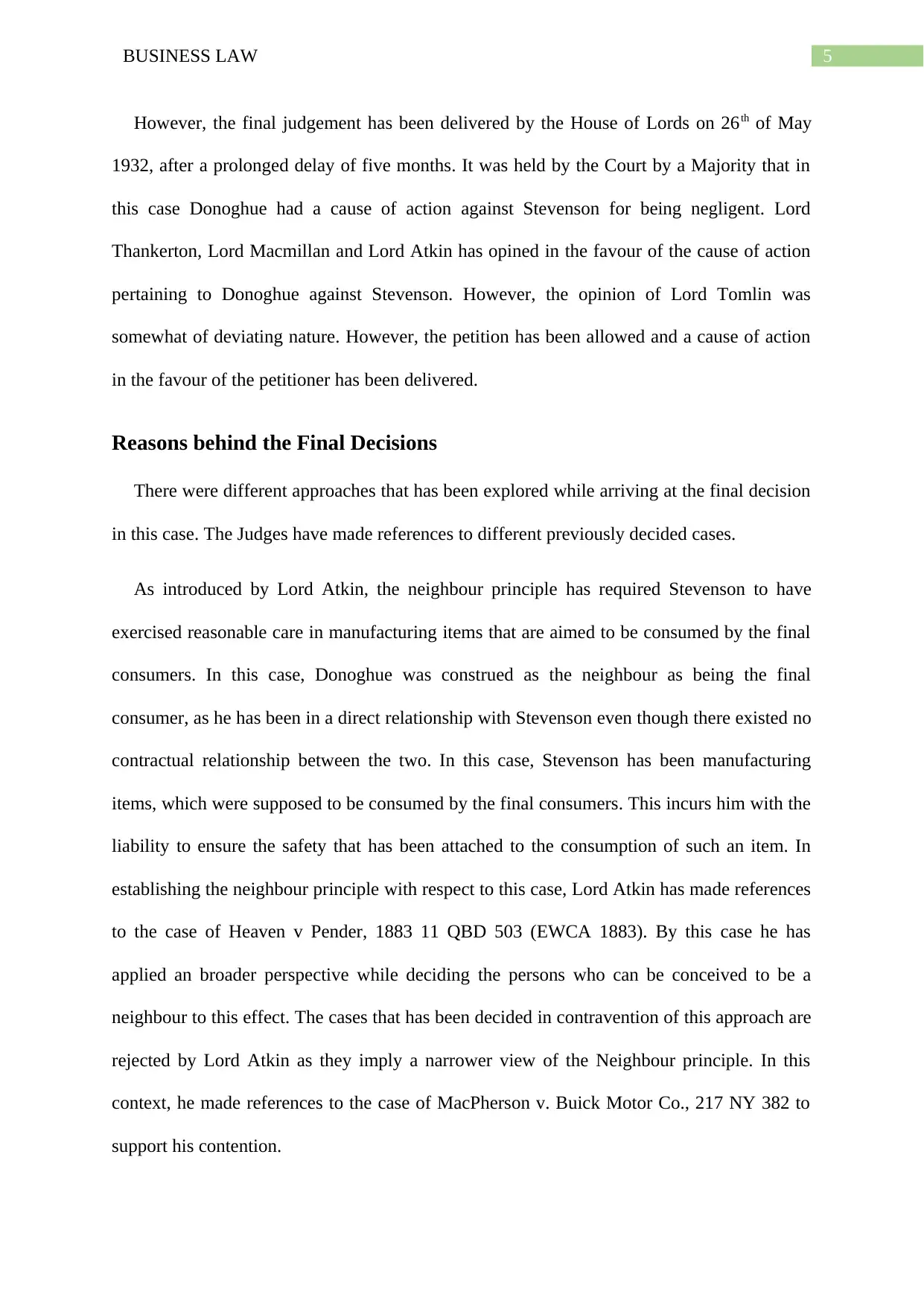
5BUSINESS LAW
However, the final judgement has been delivered by the House of Lords on 26th of May
1932, after a prolonged delay of five months. It was held by the Court by a Majority that in
this case Donoghue had a cause of action against Stevenson for being negligent. Lord
Thankerton, Lord Macmillan and Lord Atkin has opined in the favour of the cause of action
pertaining to Donoghue against Stevenson. However, the opinion of Lord Tomlin was
somewhat of deviating nature. However, the petition has been allowed and a cause of action
in the favour of the petitioner has been delivered.
Reasons behind the Final Decisions
There were different approaches that has been explored while arriving at the final decision
in this case. The Judges have made references to different previously decided cases.
As introduced by Lord Atkin, the neighbour principle has required Stevenson to have
exercised reasonable care in manufacturing items that are aimed to be consumed by the final
consumers. In this case, Donoghue was construed as the neighbour as being the final
consumer, as he has been in a direct relationship with Stevenson even though there existed no
contractual relationship between the two. In this case, Stevenson has been manufacturing
items, which were supposed to be consumed by the final consumers. This incurs him with the
liability to ensure the safety that has been attached to the consumption of such an item. In
establishing the neighbour principle with respect to this case, Lord Atkin has made references
to the case of Heaven v Pender, 1883 11 QBD 503 (EWCA 1883). By this case he has
applied an broader perspective while deciding the persons who can be conceived to be a
neighbour to this effect. The cases that has been decided in contravention of this approach are
rejected by Lord Atkin as they imply a narrower view of the Neighbour principle. In this
context, he made references to the case of MacPherson v. Buick Motor Co., 217 NY 382 to
support his contention.
However, the final judgement has been delivered by the House of Lords on 26th of May
1932, after a prolonged delay of five months. It was held by the Court by a Majority that in
this case Donoghue had a cause of action against Stevenson for being negligent. Lord
Thankerton, Lord Macmillan and Lord Atkin has opined in the favour of the cause of action
pertaining to Donoghue against Stevenson. However, the opinion of Lord Tomlin was
somewhat of deviating nature. However, the petition has been allowed and a cause of action
in the favour of the petitioner has been delivered.
Reasons behind the Final Decisions
There were different approaches that has been explored while arriving at the final decision
in this case. The Judges have made references to different previously decided cases.
As introduced by Lord Atkin, the neighbour principle has required Stevenson to have
exercised reasonable care in manufacturing items that are aimed to be consumed by the final
consumers. In this case, Donoghue was construed as the neighbour as being the final
consumer, as he has been in a direct relationship with Stevenson even though there existed no
contractual relationship between the two. In this case, Stevenson has been manufacturing
items, which were supposed to be consumed by the final consumers. This incurs him with the
liability to ensure the safety that has been attached to the consumption of such an item. In
establishing the neighbour principle with respect to this case, Lord Atkin has made references
to the case of Heaven v Pender, 1883 11 QBD 503 (EWCA 1883). By this case he has
applied an broader perspective while deciding the persons who can be conceived to be a
neighbour to this effect. The cases that has been decided in contravention of this approach are
rejected by Lord Atkin as they imply a narrower view of the Neighbour principle. In this
context, he made references to the case of MacPherson v. Buick Motor Co., 217 NY 382 to
support his contention.
⊘ This is a preview!⊘
Do you want full access?
Subscribe today to unlock all pages.

Trusted by 1+ million students worldwide
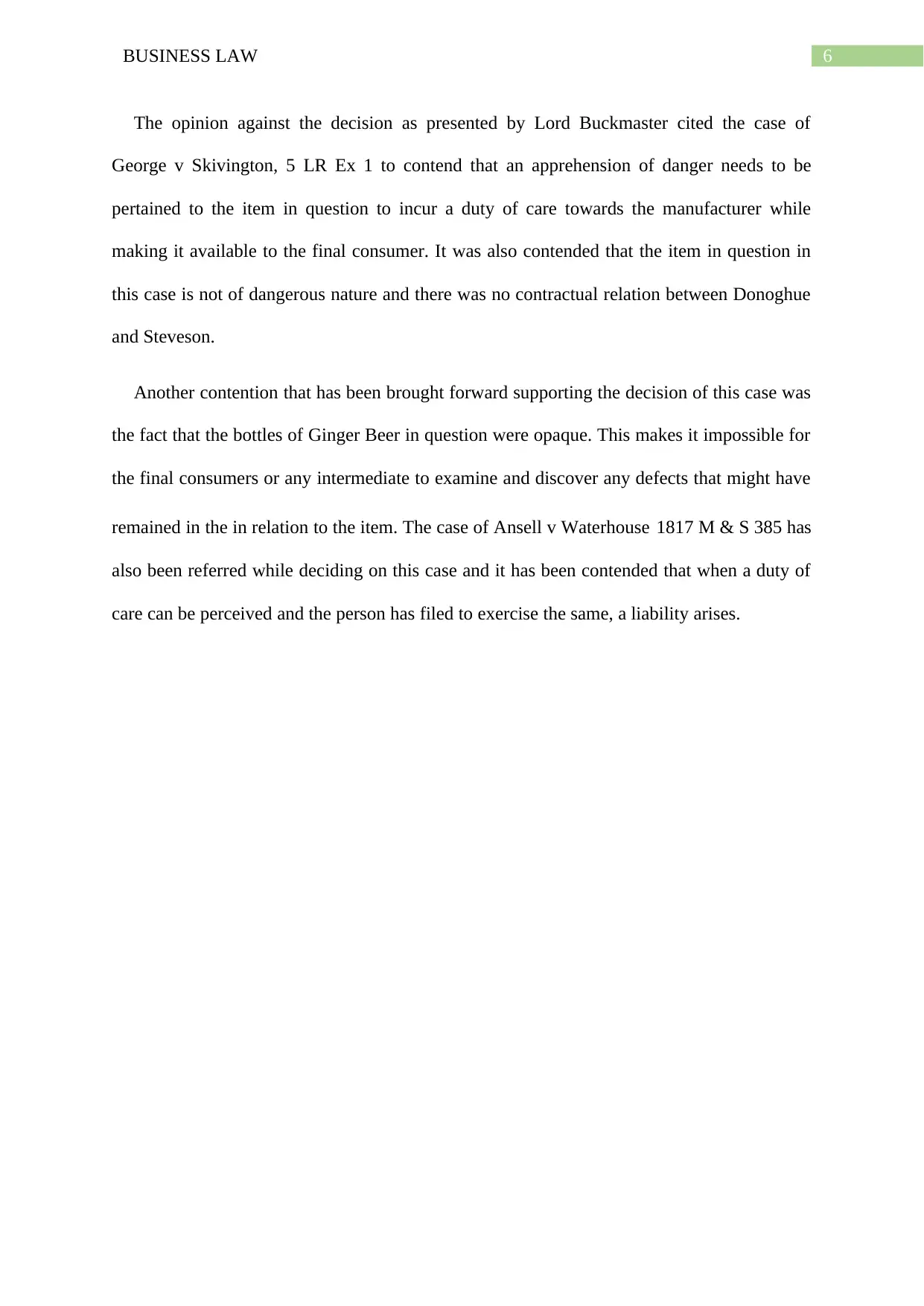
6BUSINESS LAW
The opinion against the decision as presented by Lord Buckmaster cited the case of
George v Skivington, 5 LR Ex 1 to contend that an apprehension of danger needs to be
pertained to the item in question to incur a duty of care towards the manufacturer while
making it available to the final consumer. It was also contended that the item in question in
this case is not of dangerous nature and there was no contractual relation between Donoghue
and Steveson.
Another contention that has been brought forward supporting the decision of this case was
the fact that the bottles of Ginger Beer in question were opaque. This makes it impossible for
the final consumers or any intermediate to examine and discover any defects that might have
remained in the in relation to the item. The case of Ansell v Waterhouse 1817 M & S 385 has
also been referred while deciding on this case and it has been contended that when a duty of
care can be perceived and the person has filed to exercise the same, a liability arises.
The opinion against the decision as presented by Lord Buckmaster cited the case of
George v Skivington, 5 LR Ex 1 to contend that an apprehension of danger needs to be
pertained to the item in question to incur a duty of care towards the manufacturer while
making it available to the final consumer. It was also contended that the item in question in
this case is not of dangerous nature and there was no contractual relation between Donoghue
and Steveson.
Another contention that has been brought forward supporting the decision of this case was
the fact that the bottles of Ginger Beer in question were opaque. This makes it impossible for
the final consumers or any intermediate to examine and discover any defects that might have
remained in the in relation to the item. The case of Ansell v Waterhouse 1817 M & S 385 has
also been referred while deciding on this case and it has been contended that when a duty of
care can be perceived and the person has filed to exercise the same, a liability arises.
Paraphrase This Document
Need a fresh take? Get an instant paraphrase of this document with our AI Paraphraser

7BUSINESS LAW
Reference
Ansell v Waterhouse 1817 M & S 385
Donoghue v Stevenson [1932] UKHL 100
Evans-Jones, R. and Scott, H., 2018. Lord Atkin, Donoghue v Stevenson and the Lex
Aquilia: Civilian Roots of the “Neighbour” Principle. In Wrongful Damage to Property in
Roman Law: British Perspectives. Edinburgh University Press.
George v Skivington, 5 LR Ex 1
Hage, J., 2017. Legal reasoning. In Introduction to law (pp. 21-31). Springer, Cham.
Heaven v Pender, 1883 11 QBD 503 (EWCA 1883)
MacPherson v. Buick Motor Co., 217 NY 382
Mullen v AG Barr & Co Ltd 1929 S.C. 461, 1929 S.L.T. 341
Reference
Ansell v Waterhouse 1817 M & S 385
Donoghue v Stevenson [1932] UKHL 100
Evans-Jones, R. and Scott, H., 2018. Lord Atkin, Donoghue v Stevenson and the Lex
Aquilia: Civilian Roots of the “Neighbour” Principle. In Wrongful Damage to Property in
Roman Law: British Perspectives. Edinburgh University Press.
George v Skivington, 5 LR Ex 1
Hage, J., 2017. Legal reasoning. In Introduction to law (pp. 21-31). Springer, Cham.
Heaven v Pender, 1883 11 QBD 503 (EWCA 1883)
MacPherson v. Buick Motor Co., 217 NY 382
Mullen v AG Barr & Co Ltd 1929 S.C. 461, 1929 S.L.T. 341
1 out of 8
Related Documents
Your All-in-One AI-Powered Toolkit for Academic Success.
+13062052269
info@desklib.com
Available 24*7 on WhatsApp / Email
![[object Object]](/_next/static/media/star-bottom.7253800d.svg)
Unlock your academic potential
Copyright © 2020–2025 A2Z Services. All Rights Reserved. Developed and managed by ZUCOL.





